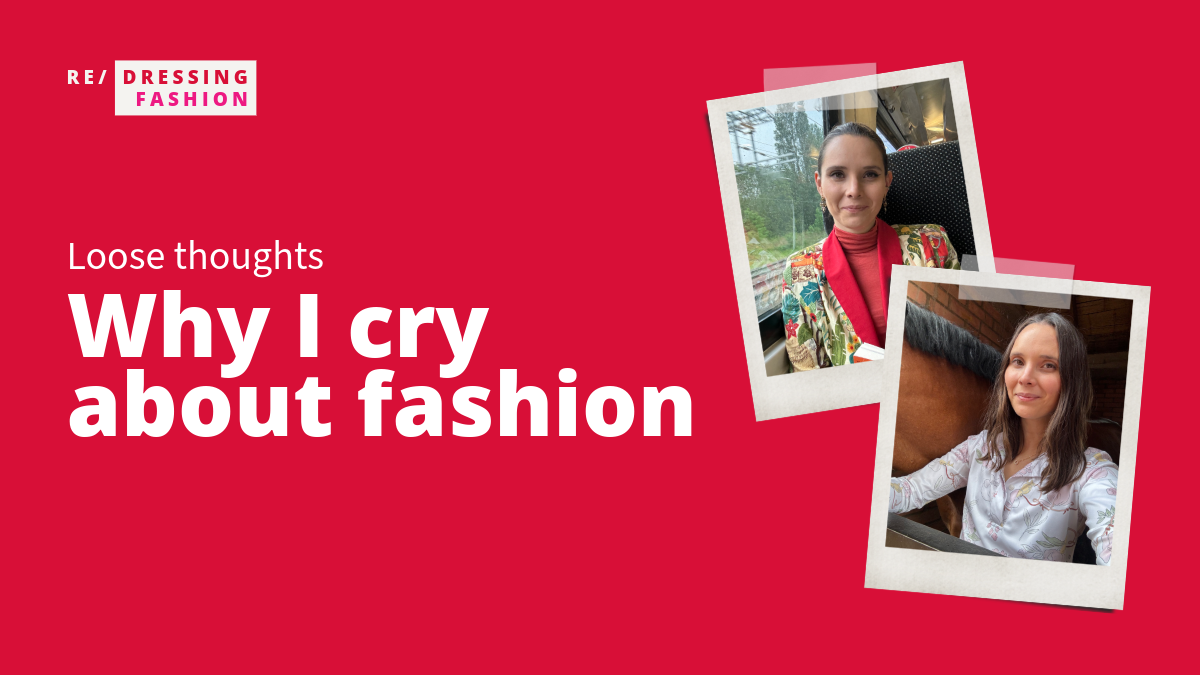Dear fashion thinkers,
You may be aware at this point that I take fashion very seriously. So much so that I even cry about it much more often than I’d like to admit. It just feels impossible not to, with all the damage that fashion—and not just the industry—does to us and the world.
Ironically, I chose to leave my nascent career as an economist for one in fashion history more than ten years ago because I didn’t want to cry about my work. I thought fashion would never make me feel angry or frustrated, as I did at the sense of powerlessness brought about by trying to fight against poverty, inequality, and discrimination. I thought writing fashion history would be easier than designing public policies for such an unjust world that we live in.
If someone had warned me that I was completely wrong, I would have laughed at their face—being aware as I was, even back then, of fashion’s immense power in shaping human identities, societies, and politics.
But now, a decade later, I’ve become more and more convinced that trying to “redress” fashion, as I like to call the process of transforming it into something more equitable and diverse, is just as difficult as changing our world for the better.
The reason?
First, because fashion is the most perfect reflection of human societies, while also giving shape to them. As a result, transforming our (very rotten, dare I say) contemporary society must go hand in hand with restructuring fashion.
I also don’t think any of the big players in the fashion industry are interested in truly modifying the status quo. And, unfortunately, there’s only so much that our consumer pockets, activism, or even the smaller companies striving for change can do if those who have the money—and thus power—to actually change things are not on board.
And thirdly, I wonder how long it will take for all of us who are so passionately invested in and trying to generate some significant change in fashion—and our world—to burn out and give up.
In my last “loose thoughts” I wrote about fashion’s burnout epidemic. You may remember that I mentioned a report concluding that burnout is especially harsh on purpose-driven professionals, the people whose main work objective is to spark change in terms of equity, diversity, ethics, and sustainability.
And they (we) burn out precisely because, no matter how much we work or the insane amounts of effort and care we put into our ideas and initiatives, little changes in the industry. And we know at this point that there’s only so much we can do.
I, for sure, know that I feel so frustrated with fashion—and thus shed so many sad tears about it—precisely because it matters to me, because I’ve internalized a sort of responsibility to actively work to make things better, and because I realize that, even if I dedicate an entire life to redressing fashion, I probably won’t see any significant change on my own. I’ve also started to doubt that we’ll get any important industry players on board any time soon.
The pressure—and the feeling of powerlessness—are so huge, that it’s impossible not to want to quit fashion sometimes. (I bet many of those purpose-driven professionals who participated in the Vogue Business’s survey on fashion’s burnout crisis that I cited last time cry just as much as I do.)
Someone suggested on an Instagram comment the other day that maybe I cry about fashion—and public policy—just because I’m sensitive. And while I am a sensitive girl, that is definitely not why I cry so much about fashion.
I cry about fashion because of all its injustice and the frustration and the sense of powerlessness I get at just the thought of trying to change it. I cry because, even if we’ve all been talking about the need to produce and consume fashion more sustainably for years, the market remains pretty much the same. I cry because “decolonization” has become a shallow, trendy word, thus losing much of its true meaning and revolutionary potential.
But just as I cry “sad” (and frustrated and angry and powerless) tears about fashion, some days I also cry “happy” tears.
I cry happy tears about fashion when I see little sparkles of change within all the darkness of discrimination, injustice, and overconsumption. I cry happy tears when I’m inspired by some of the amazing creatives I have the honor of sharing and working with. I definitely cried happy tears when I convinced a designer I’m advising not to fall in the trap of exoticization in trying to develop a specific “Latin American” aesthetic for their upcoming collection.
So I choose to remain hopeful. And I hope that those of us who truly care, who are willing to do the difficult work and stand against an entire industry, can get together to support each other, build collectively, and one day effect some real change.
If you know me, you know that I’m a big proponent of collective action. And when it comes to replacing angry tears about fashion with happy, hopeful tears, I’ve started to think that collectivity is also the key.
Maybe that’s why I created an entire Redressing Fashion Club to facilitate safe spaces for conversation and community building, or why I insist on collaborating with fashion brands and designers even though my time is becoming more and more scarce. (But those two are subjects of entirely different conversations.)
What do you think it’ll take to start shedding more happy tears about fashion? Please share your ideas by leaving a comment, reaching out to me on social media, or replying to my email newsletter. I’d love to know your thoughts!
As always, thank you, thank you for reading, watching, and joining the conversation.
Until next time,
—L 🩷
PS. Remember you can subscribe to my email list to receive blog updates directly to your inbox.

Leave a Reply